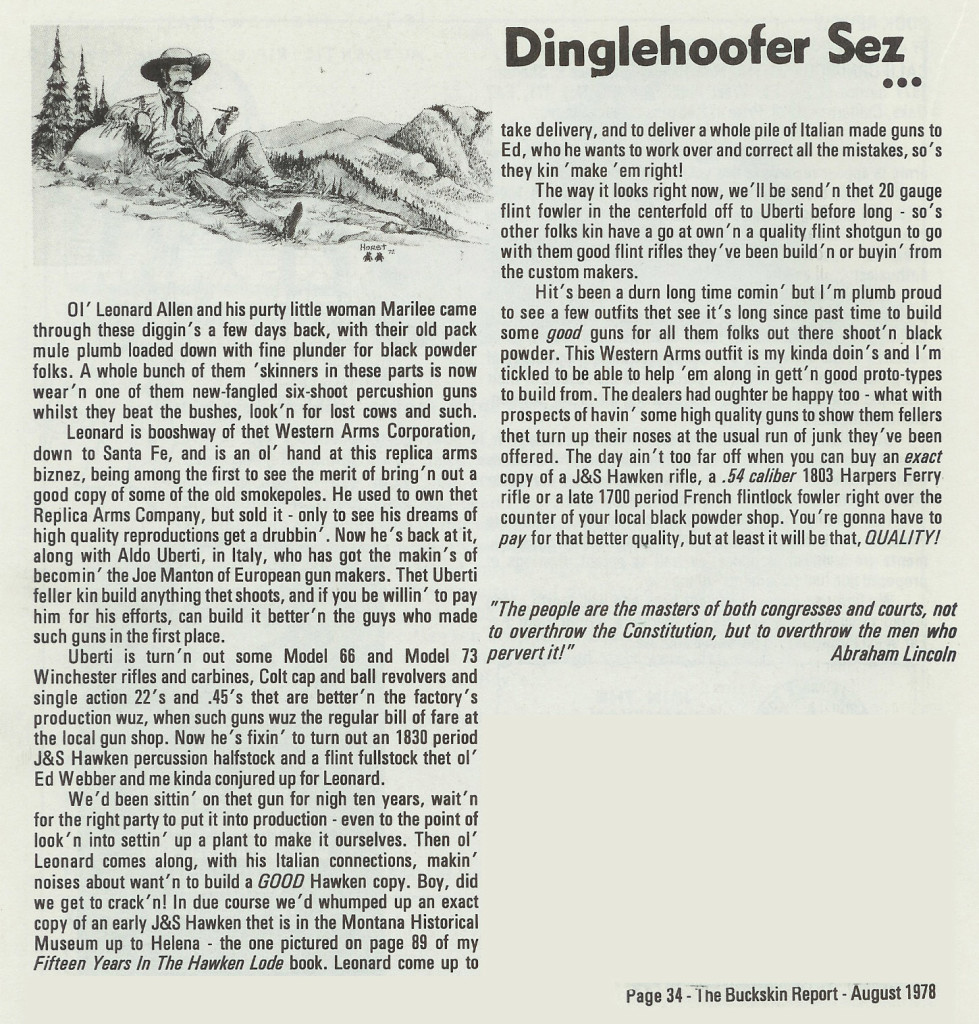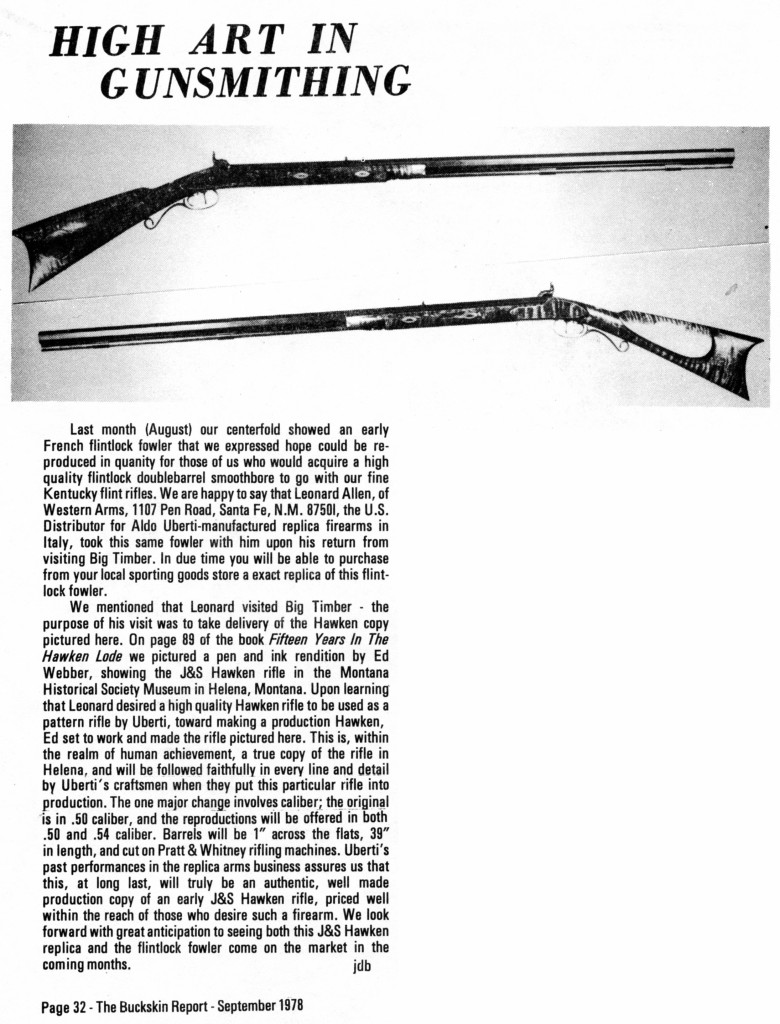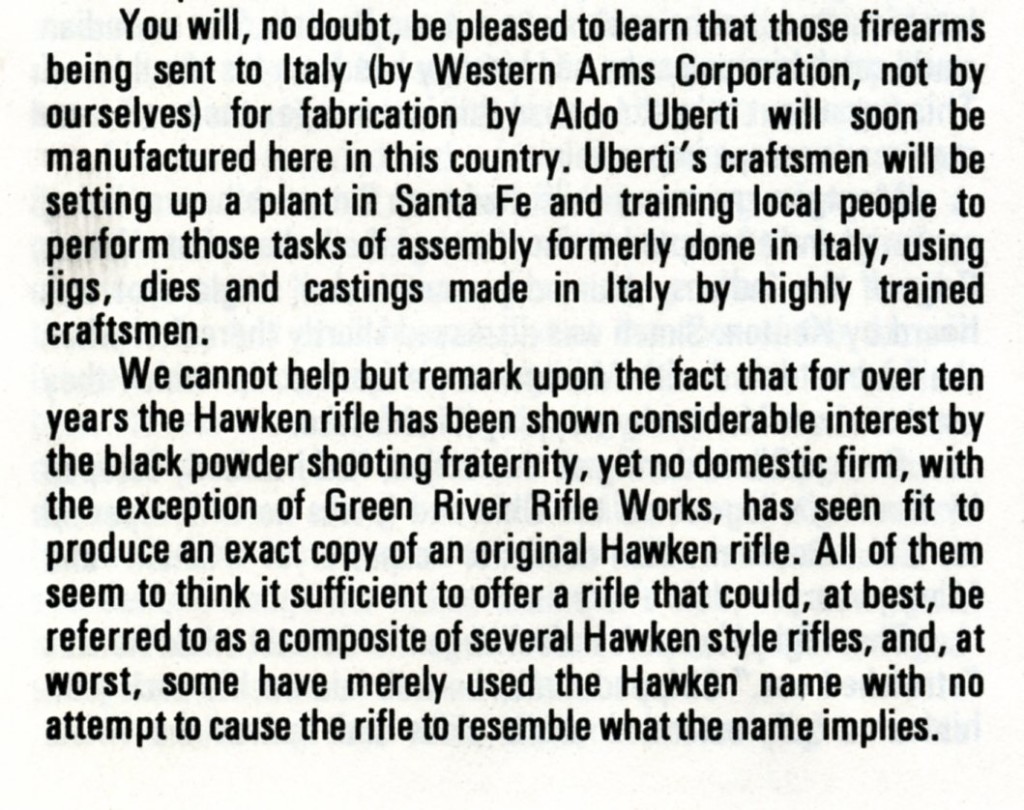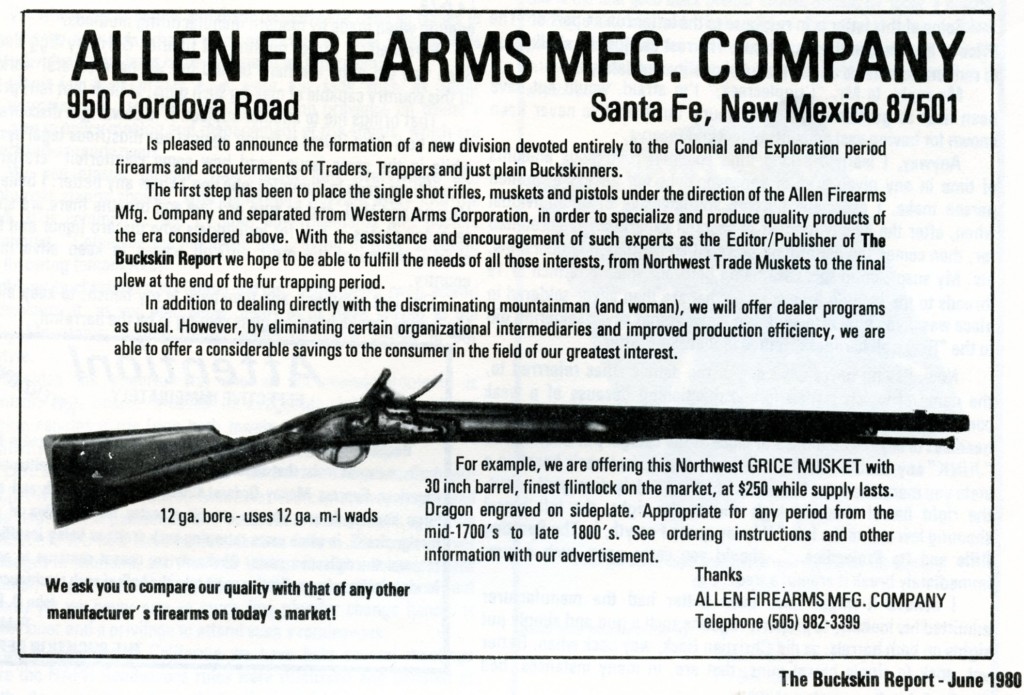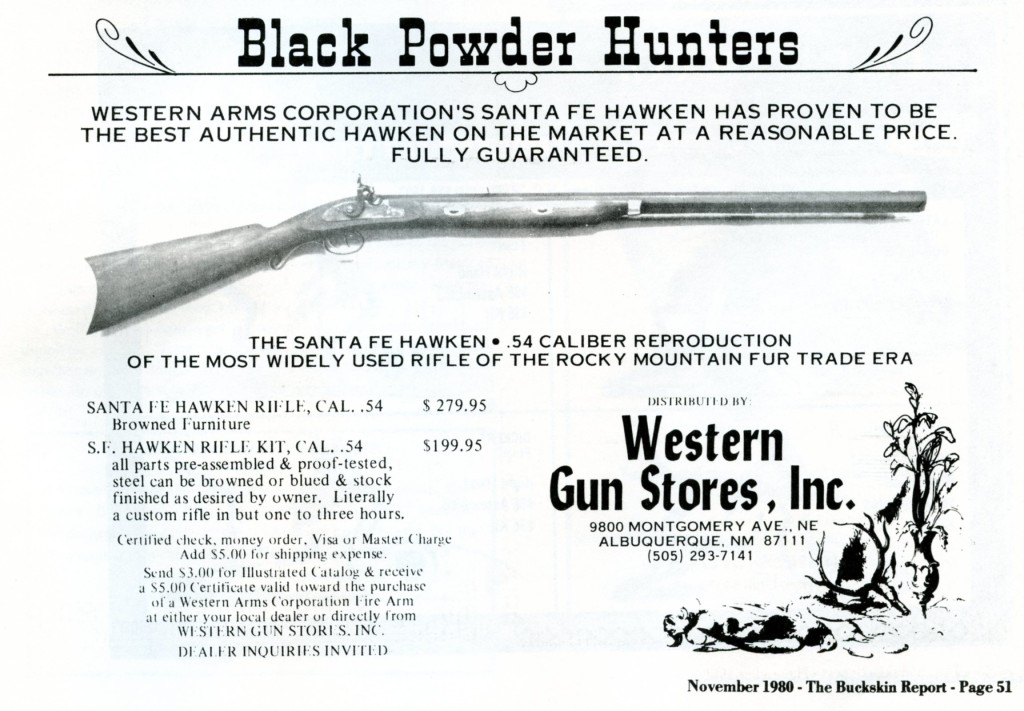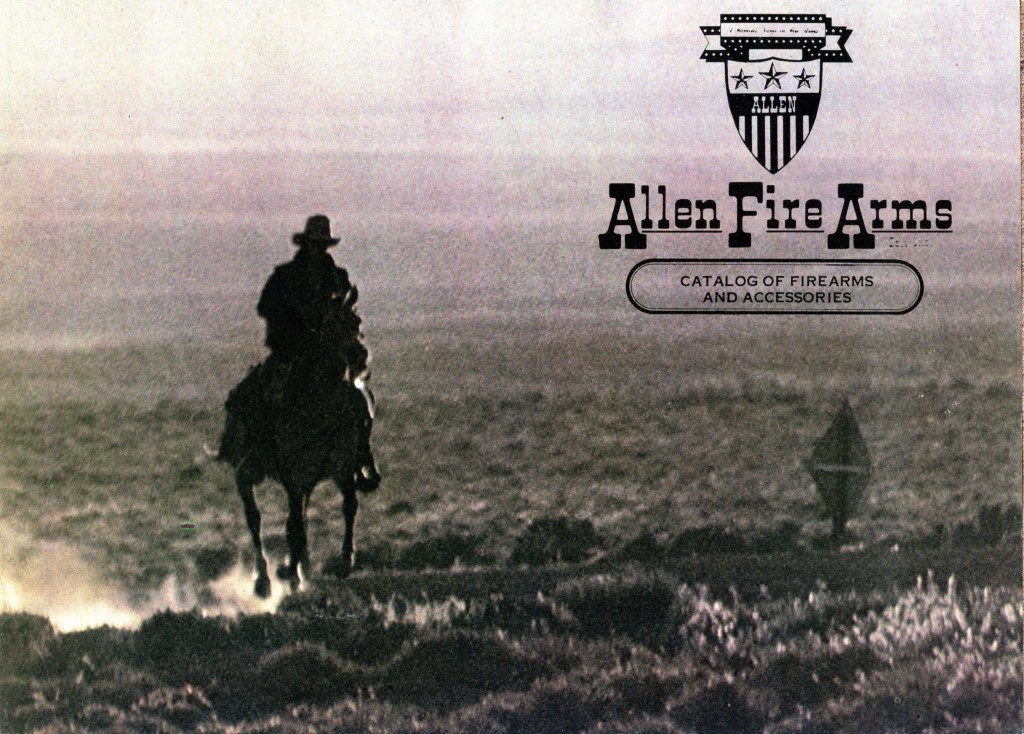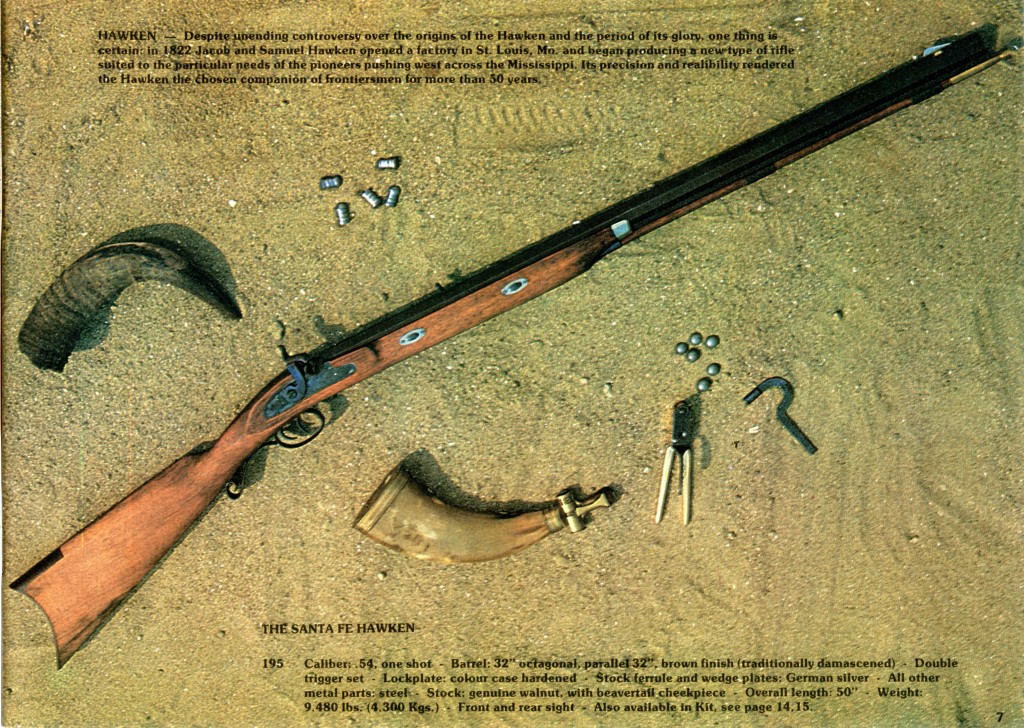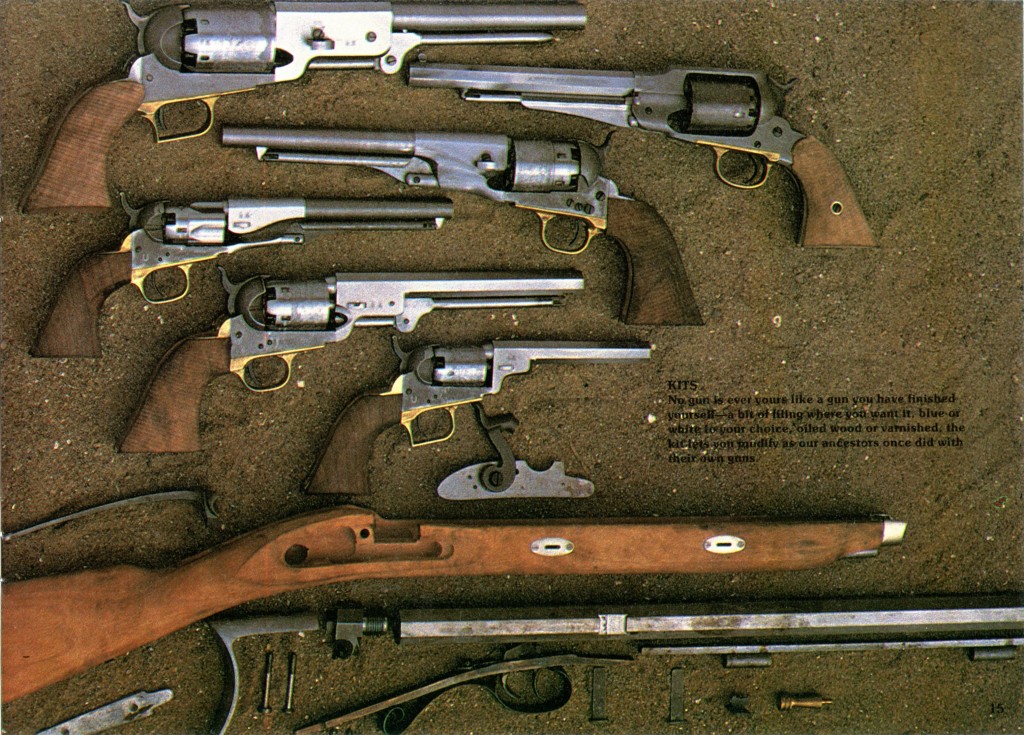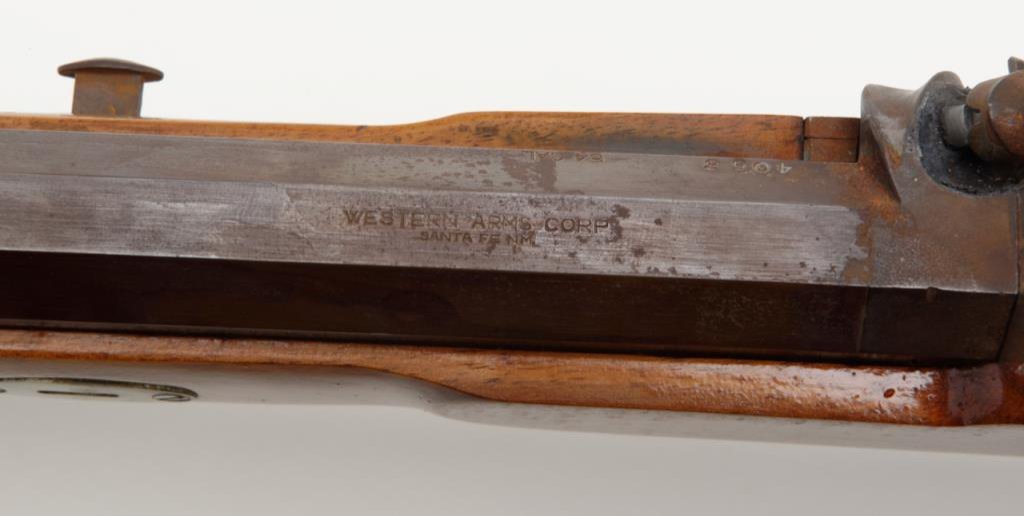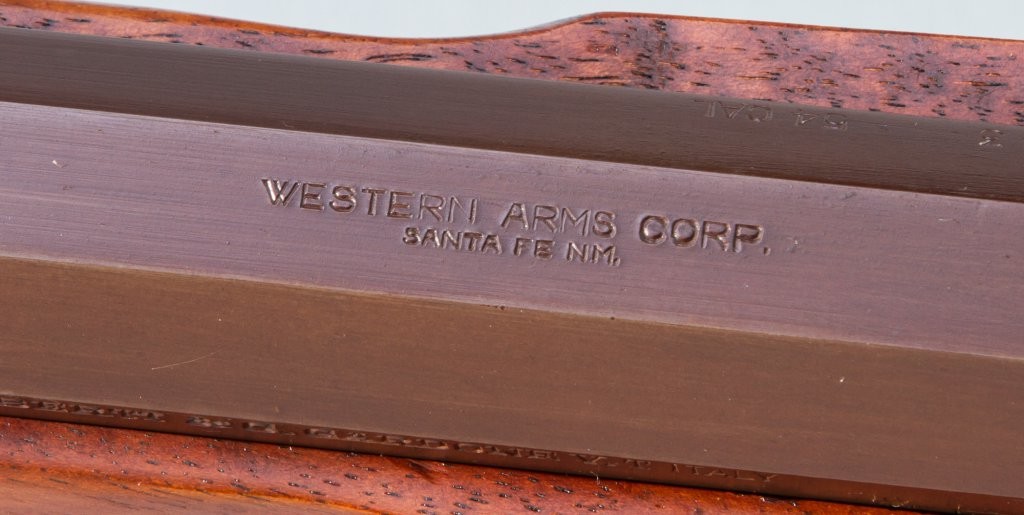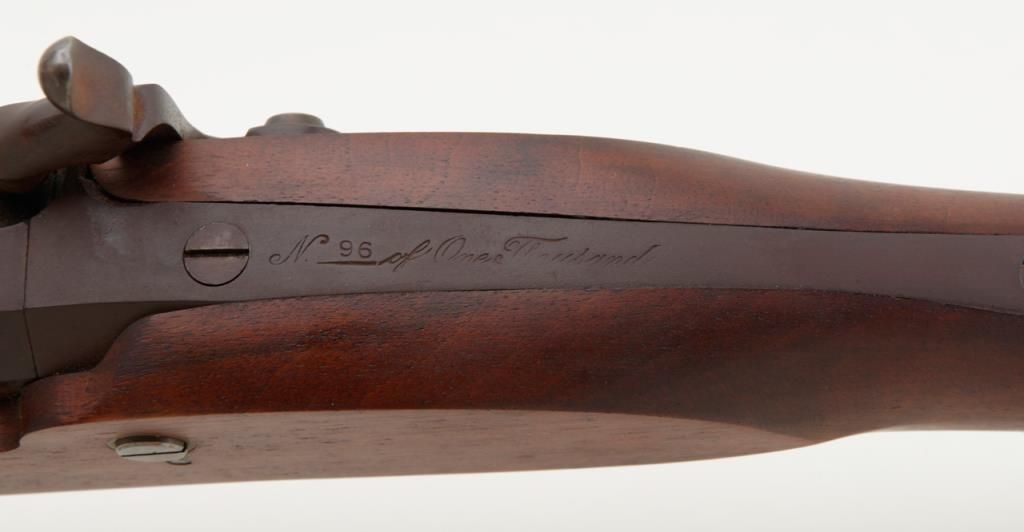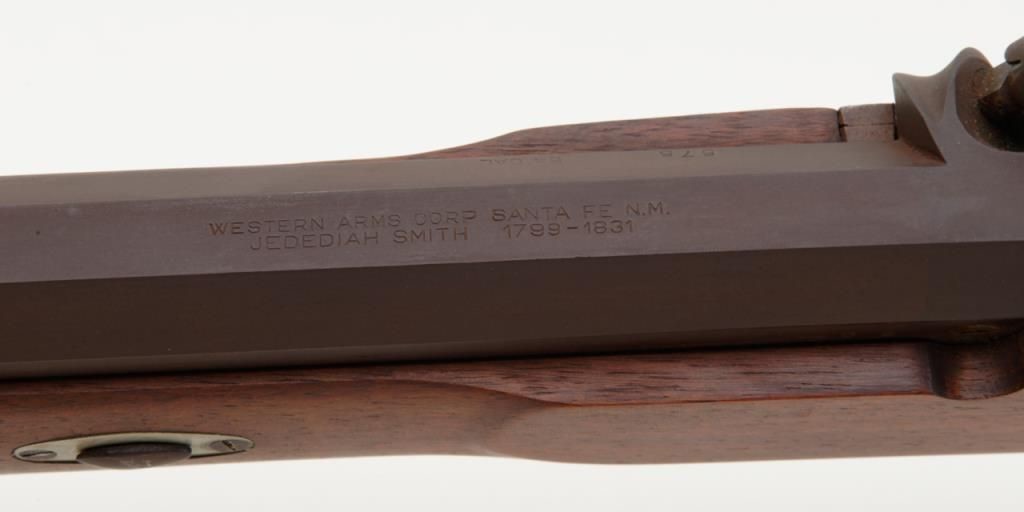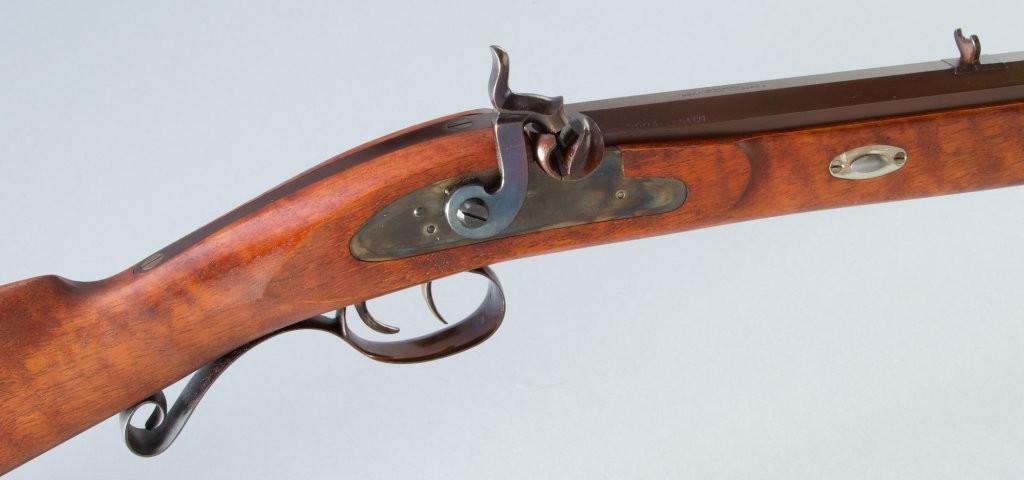COMPANY HISTORY
Aldo Uberti was the first Italian manufacturer to build a reproduction Colt black powder pistol back in 1959. That year, the company began making a copy of the Colt 1851 Navy for Val Forgett of Navy Arms. A. Uberti & Co. became the premier Italian manufacturer of the complete line of Colt black powder pistols, Remington pistols, and Winchester rifles and sold firearms to Navy Arms, Dixie Gun Works, and other early importers of cap and ball pistols that sprung up during and after the Civil War Centennial.In the 1970’s, Leonard Allen of Western Arms Corp. began working with Uberti to manufacture a line of cap and ball pistols that were a little higher quality than what the other importers were selling. The success of that effort encouraged Allen to work with Uberti to develop new firearms. That led to a cooperative effort to develop a mass produced Hawken rifle.
Leonard Allen actually planned a whole line of Hawken rifles and announced the new Hawken rifle with a notice in May-June 1978 issue of Muzzleloader magazine. Allen called this Uberti import the Santa Fe Hawken.
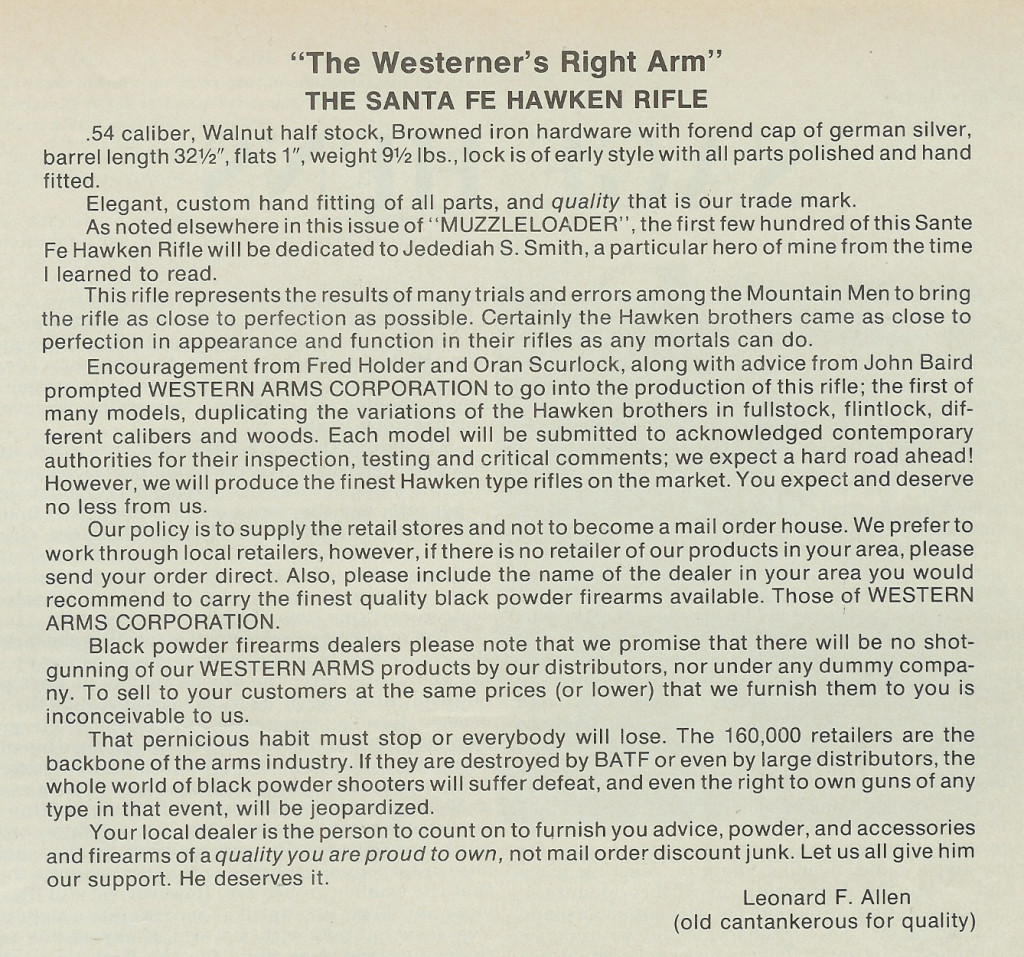
The same May-June 1978 issue of Muzzleloader magazine carried this advertisement from Western Arms Corp. Allen also thought the market might be right for some commemorative black powder arms and used the same advertisement to introduce a limited edition Colt Texas Dragoon Model 1862 pistol and a Jedediah Smith Hawken rifle. The Jedediah Smith Commemorative Hawken was essentially the same as the Santa Fe Hawken and was included in the Santa Fe Hawken serial number range. The Jedediah Smith Hawken had different barrel markings and a Limited Edition numbering “N. xxxx of One Thousand” stamped in script on the tang.

This ad was continued in every remaining issue of the magazine for the rest of the year and into 1979. Considering the common practice in the firearms industry to start advertising prior to the availability of the actual firearms to create some pent-up demand, I suspect the issue date for both rifles was 1979. The development of the rifle probably started much earlier such as 1977.
In the August 1978 issue of The Buckskin Report, John Baird had this little write-up about Leonard Allen visiting Montana. In addition to a little more background on Allen such as he was a previous owner of Replica Arms Company, Baird mentions that he and Ed Webber were working with Allen on a project to produce a new replica of a J&S Hawken rifle, one of the other Hawken rifles Allen was planning. This would become known as the Baird-Webber J&S Hawken.
The next month, Baird had another column about Leonard Allen and the Baird-Webber J&S Hawken they expected to get Uberti to make.
In the October 1978 issue of The Buckskin Report, Allen ran this ad showing both the Santa Fe Hawken as the S. Hawken version and the Baird-Webber Hawken as the J&S Hawken version.
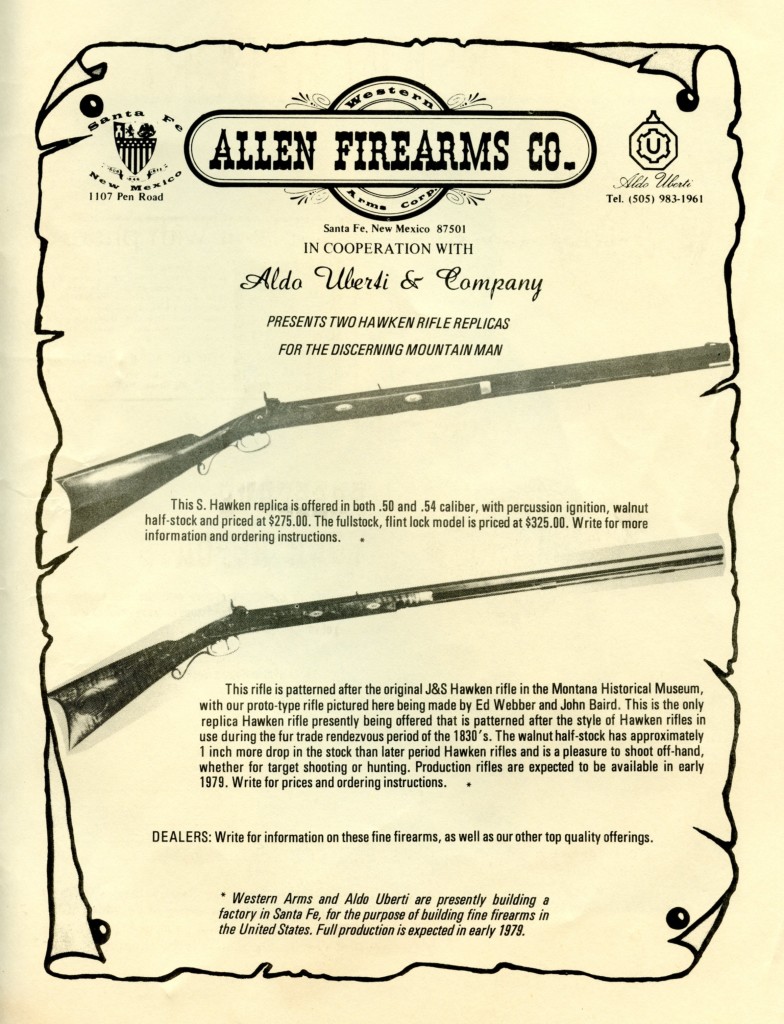
This ad clearly indicates that Allen was trying to develop the Santa Fe Hawken and the Baird-Webber J&S Hawken rifles at the same time.
Note that the ad says Western Arms and Uberti are building a factory in the USA to manufacture the rifles. Baird elaborated on this further in the same issue.
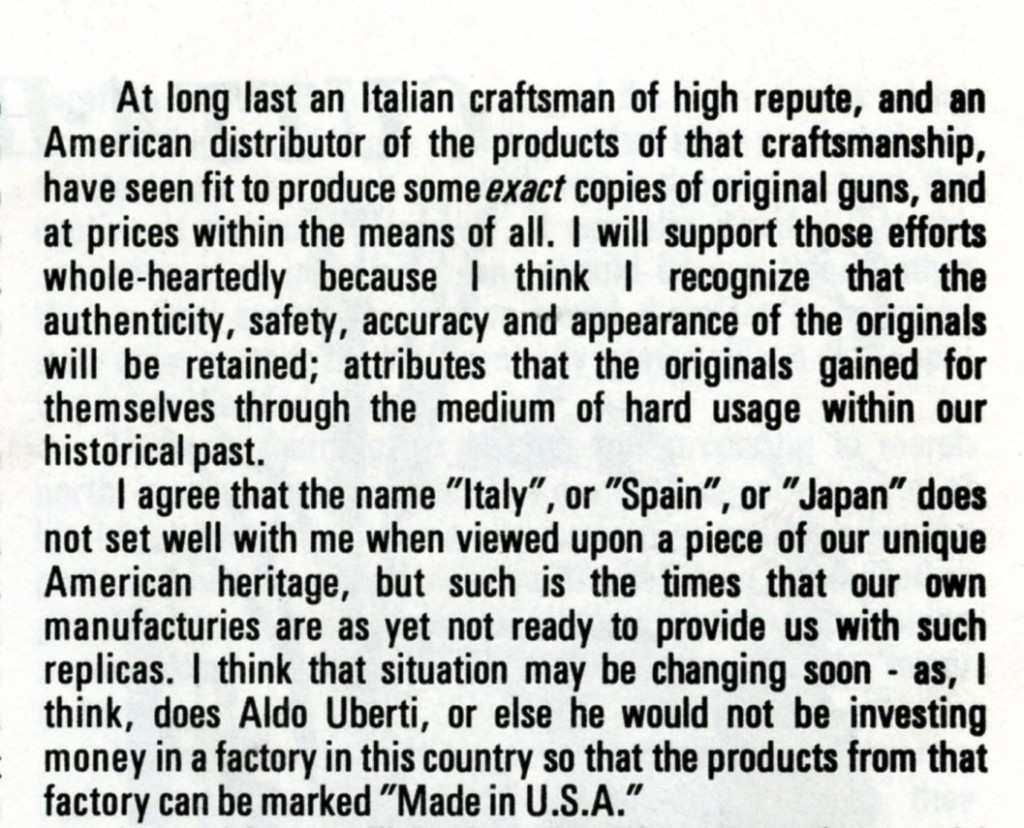
In the April 1979 issue of The Buckskin Report, Western Arms ran this ad. Note that this ad is pretty much the same as the previous ad, but there is no mention of Western Arms and Uberti building a factory in the USA.
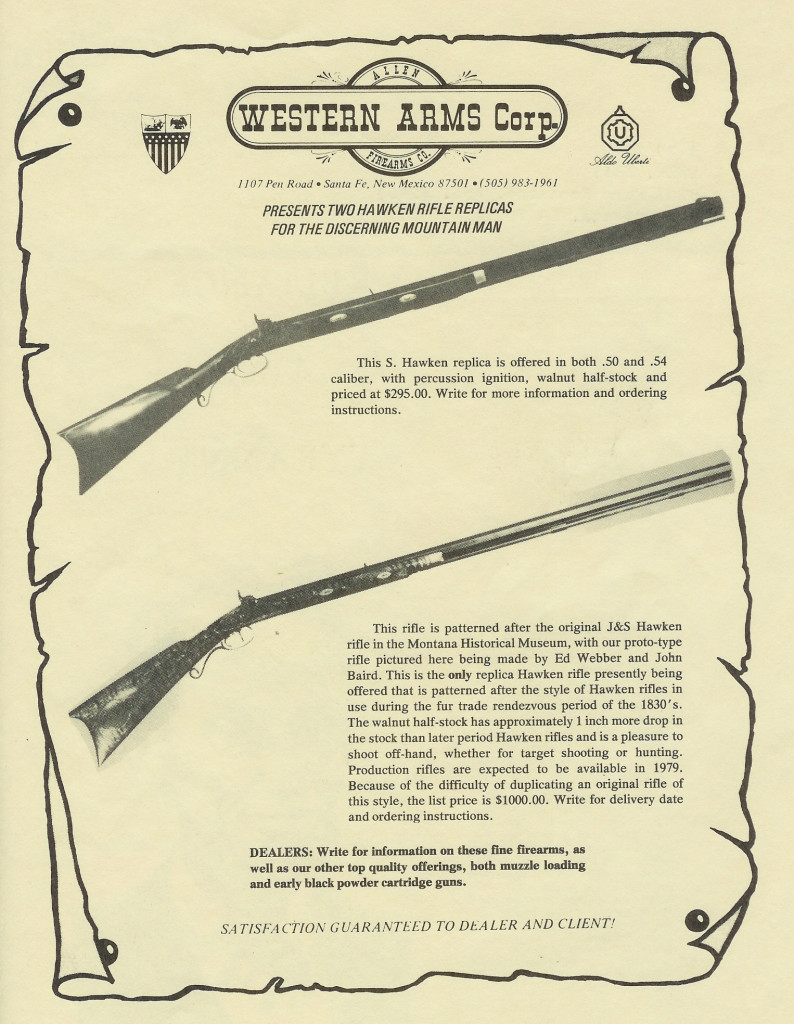
By November 1979, Baird was still writing about the Baird-Webber J&S Hawken, but acknowledges that its production had been delayed.

In the February 1980 The Buckskin Report, Baird wrote another long article about the Baird-Webber J&S Hawken, how it came about, its specifications and description from a Western Arms Corp catalog, and included a picture of the first production version of the rifle being held by Marilee Allen.
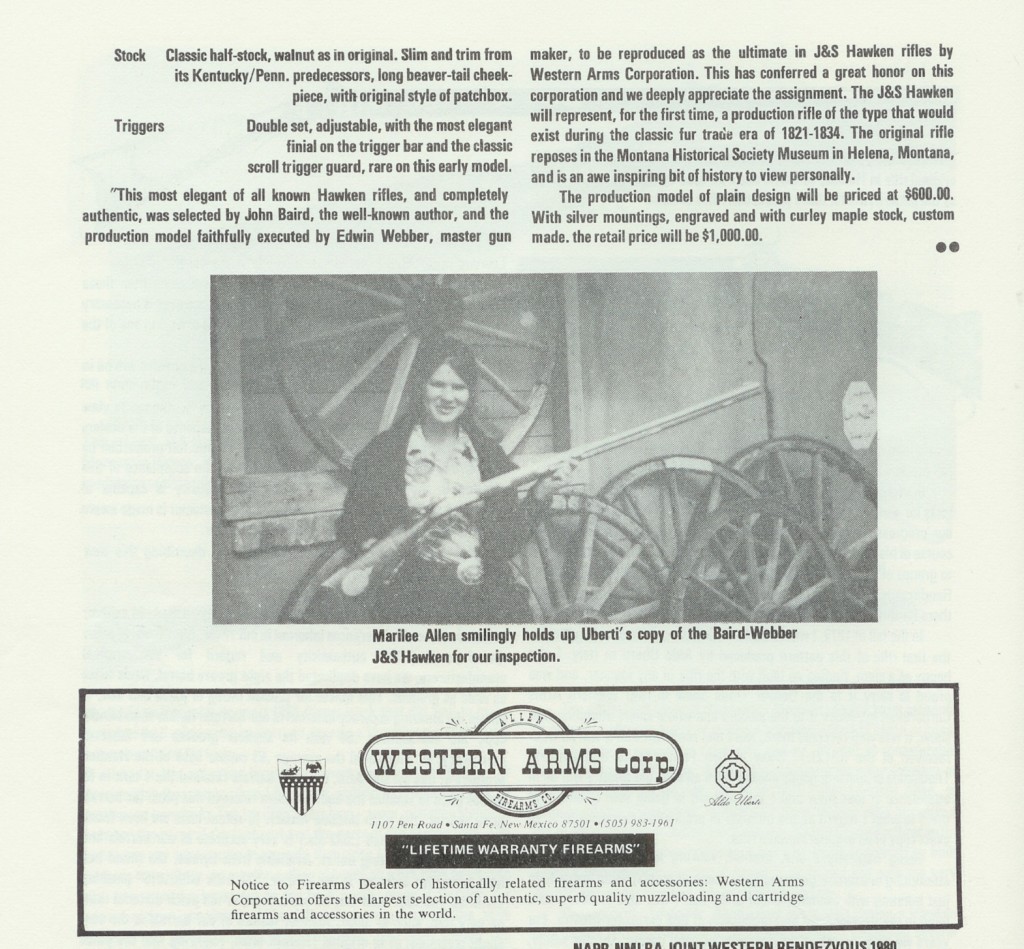
In spite of all the optimism and excitement shown by John Baird, Western Arms Corp was having problems. The biggest was likely a lawsuit by Olin Corporation for trade name infringement with the company name, Western Arms Corp. Olin Corporation owned Winchester Western ammunition. Leonard Allen was forced to dissolve Western Arms Corp and two separate companies were formed as indicated by the following ads from the June 1980 issue of Buckskin Report to dispose of the firearms that were marked “Western Arms Corp”.
The Barid-Webber J&S Hawken rifle did not survive the turmoil and never went into full production, but the Santa Fe Hawken did. This staff report on the Santa Fe Hawken was published in the May-June 1980 issue of the Muzzleloader.
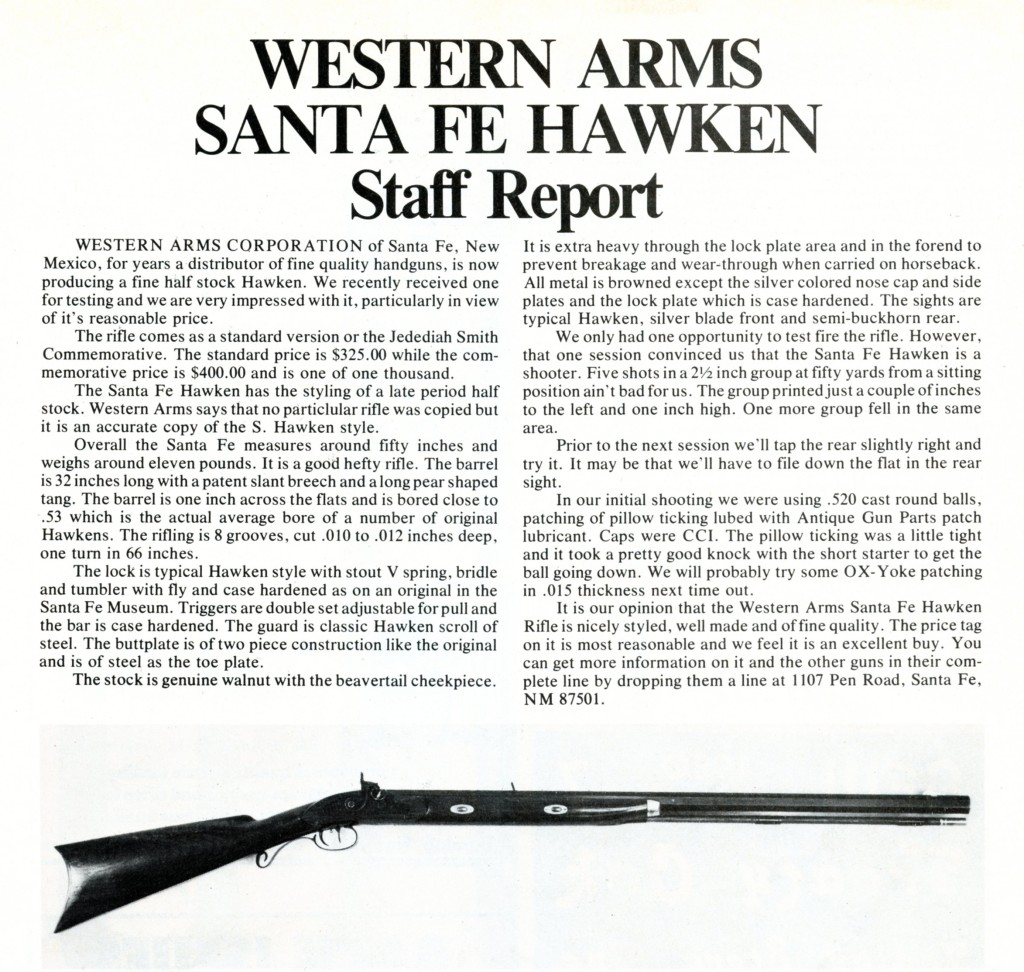
Sales of the Santa Fe Hawken and the Jedediah Smith Commemorative Hawken rifles continued into 1981 through Western Gun Store, Inc. and another company in Texas called Three Forks Trading Co.

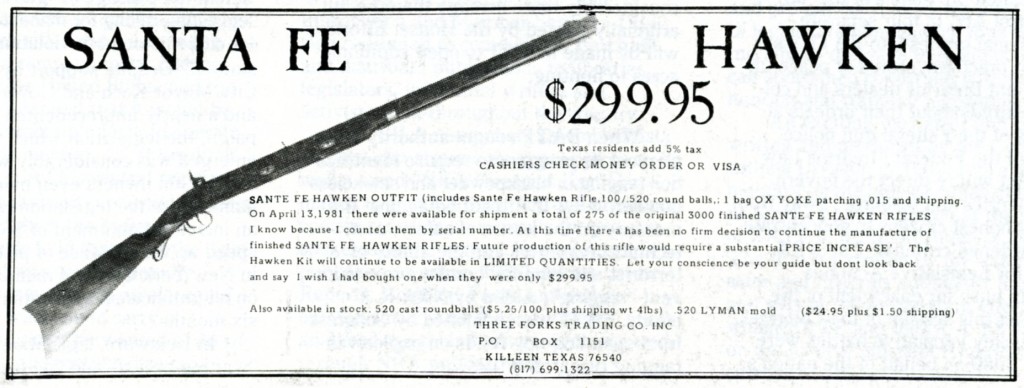
The Santa Fe Hawken survived Western Arms Corp. Leonard Allen continued to operate Allen Firearms Co., which was either a parent company or sister company to Western Arms Corp. As this catalog from 1983 shows, Allen Firearms was still carrying the Santa Fe Hawken.
The Blue Book of Modern Black Powder Values, First Edition, by Dennis Adler says Allen Firearms went out of business in 1987, and that Old-West Gun Co., now Cimarron F.A. in Fredericksburg, TX, bought the remaining inventory of Allen Firearms.
But that wasn’t the end of the Uberti Hawken. Cimarron F.A. continued to market the Santa Fe Hawken for a number of years under their name. In fact, they still list one on their web page, but it is currently manufactured by Pedersoli.
Other companies such as the Log Cabin Shop and Track of the Wolf sold Uberti Hawken rifles in factory finished form and as kits in the 1980’s. The Log Cabin Shop ran this ad in the Nov-Dec 1984 issue of Muzzleloader for the Uberti Hawken.
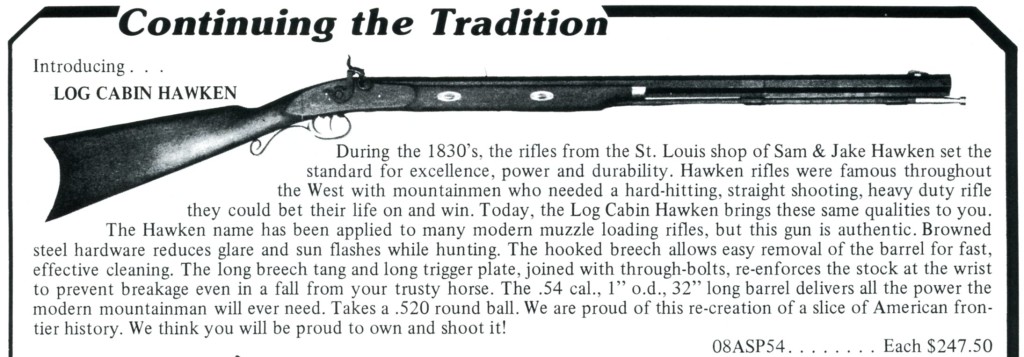
Track of the Wolf listed the Santa Fe Hawken rifle in their Catalog #8 (copyrighted 1981), Catalog #9 (copyrighted 1982), Catalog #10 (copyrighted 1983, and Catalog #11 (copyrighted 1986). Catalog #8 called it the Santa Fe Hawken by Western Arms. Later catalogs listed it as made by A. Uberti.
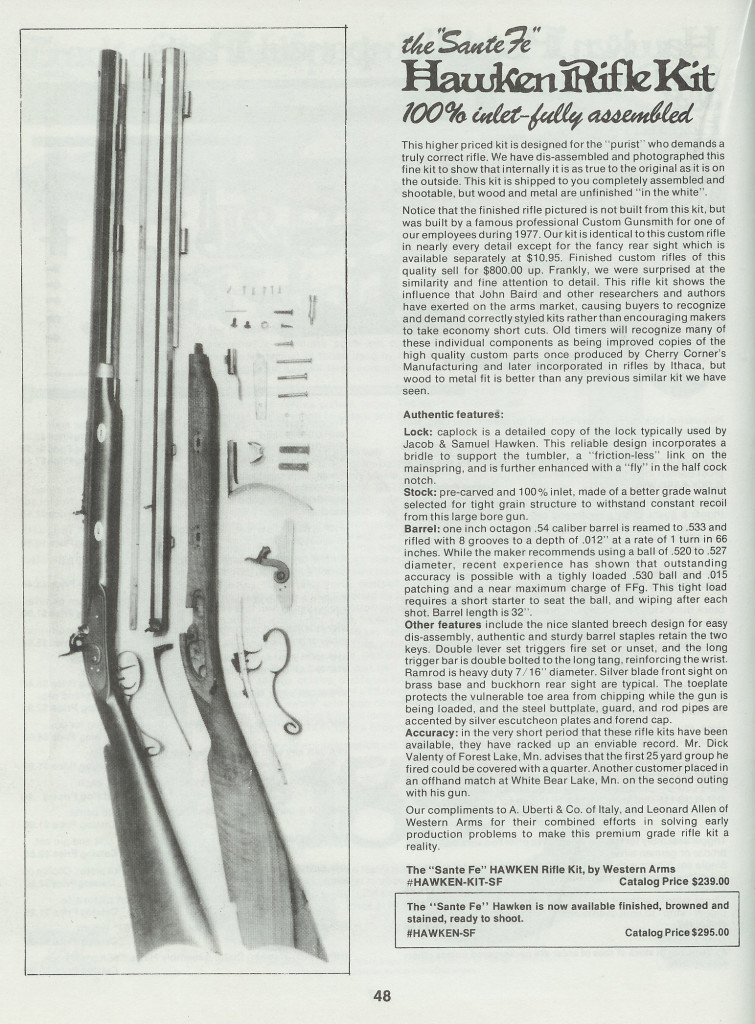
Track’s Catalog #12 (copyrighted 1991) and later versions no longer list the Uberti Santa Fe Hawken rifle.
At some point (I’m not sure of the exact date), Navy Arms quit making the Navy Arms/Ithaca Hawken in the USA with the old Cherry Corners parts and started importing the Uberti Hawken as the Navy Arms/Ithaca Hawken. I believe this continued well into the 1990’s.
Uberti may have discontinued their Hawken rifle in the mid-1990’s, but they re-issued it in the early 2000’s. Dixie Gun Works still listed the Uberti Santa Fe Hawken rifle in their 2004 catalog.
The run for the Jedediah Smith Commemorative Hawken probably reached the full 1,000 rifles. Here is a picture of SN #965 that sold at an auction in October 2011.
The total run of Western Arms Corp marked Santa Fe Hawken rifles exceeds 3,000. Here is a picture of the barrel markings on serial number 4,053 (note that the Jedediah Smith Commemoratives shared the same serial number range with the Santa Fe Hawken, so 4,053 minus 1,000 is approximately 3,000).
I have an unassembled Uberti Hawken kit that is marked on the barrel “CIMARRON ARMS CO – HOUSTON, TX”, serial number 9481 and .50 cal. The proof marks date code is AT, meaning it was proofed in 1988. Being an import, both finished rifles and kits would have to be serial numbered and shared the same serial number range. Given that these rifles continued to be imported well into the 1990’s, and for a while in the 2000’s, the total number of Uberti Hawken rifles imported by all companies is probably greater than 10,000
Debunking Some Myths and Misconceptions
You frequently see statements on the internet similar to these:
“The Santa Fe Hawken is patterned after a rifle that was carried by Kit Carson – Kit Carson’s rifle was donated to the Masonic Lodge in Santa Fe, NM.”
“The Western Arms Hawkens was never advertised as a replica of a Kit Carson Hawkens. It was advertised, and marked, as a replica of the Hawkens carried by Jed Smith on his last trip west. The original, and Western Arms #1, resides in the Palace of the Governors in Santa Fe, and was used as the pattern for the replica. This is why it is .53 cal. instead of .54 cal.”
“In the 70’s, blue prints were made of the Kit Carson Hawken rifle in the Santa Fe Masonic Lodge and sent to Italy for a limited manufacture of exact copies. Except the caliber was to be .54 (no .52” molds). The stamping on the barrel says .54 as intended but the barrels were bored and rifled as per the blue prints at .53”. That mistake is one of the identifiers of this very first and unique run. They also have the ‘slant’ breach, the fine half-dovetail locking the toe plate to the toe of the butt plate, and German silver escutcheons and fore-end cap.”
I have a sample of both the Santa Fe Hawken and the Jedediah Smith Commemorative Hawken in my collection. The two rifles are the same except for the barrel markings. They share the same serial number range, too.
Neither rifle is a copy of the Kit Carson Hawken belonging to the Masonic Lodge in Santa Fe, NM. The Uberti Hawken, in all its incarnations, has a barrel that is 1” across the flats, straight octagon, and 31⅝” long. The Kit Carson Hawken has a barrel that is 1⅛” across the flats at the breech and slightly tapered to the muzzle and is just over 31” long. The Kit Carson Hawken has all iron furnishings where the Uberti Hawken has German silver barrel key escutcheons and nose cap. Besides the difference in dimensions, the butt plate, trigger guard, hammer, and snail of the breech are not the same on the two rifles.
Neither is the Uberti Hawken a copy of a Hawken carried by Jed Smith. Smith’s pistols were recovered after his death and sent back to his family in the East, but his rifle was never recovered. We don’t even know if he was carrying a Hawken rifle when he was killed.
The New Mexico State Museum housed in the old Governors Palace in Santa Fe used to have two Hawken rifles in its collection. J.W. “Doc” Carlson published an article in the May-Jun 1979 issue of Muzzleloader magazine describing these rifles. Neither rifle was ever connected to Jed Smith. In fact, one is unmarked, but likely a S. Hawken full stock rifle that has been cut back to half stock, and the second one is marked S. Hawken. Both rifle would have been made well after Jed Smith’s death in 1831.
None of the advertising by Leonard Allen or the period product reports written about the Santa Fe Hawken claimed that the rifle is a copy of either the Kit Carson Hawken or a rifle Jed Smith carried. I have traced the claim back to the advertising of the Three Forks Trading Co. in Killeen, TX, (see ad above) where it says,
“His Hawken rifle and two pistols were traded in Santa Fe by Comancheros who had obtained them from the Comanches. Leonard Allen of Allen Firearms Mfg. Co. has copied the rifle in the Santa Fe Museum to create the Jedediah Smith Commemorative Hawken”.
It appears that this ad started the misconception that Allen copied a rifle that belonged to Jed Smith. It is pure marketing BS. Leonard Allen never made the claim himself.
It isn’t clear why the Santa Fe Hawken was marked on the barrel as a .54 caliber, but has a bore that is only 0.53” in diameter, making it in reality a .53 caliber.
The ad above for Western Gun Store, Inc says this about the caliber.
Caliber: Nominal .54 actually uses the .520” to .527” ball or the .54 Minie bullet, diameter .533”. Based on actual average bore diameter of .53” from a number of original HAWKEN rifles
I don’t know if there is any credibility to the claim that it is “based on actual average bore diameter of .53 inches from a number of original HAWKEN rifles.” To accurately measure the bore diameter would require slugging the barrel, which likely would require removing the breech plug. I doubt if this was ever done to “a number of original HAWKEN rifles”. The .53 caliber as a common caliber in Hawken rifles was cited by Hanson in The Plains Rifle[1] and by Baird in Hawken Rifles: The Mountain Man’s Choice[2], and is the likely source for the ad, but Hanson and Baird got it wrong. Even if Uberti intended to copy what they thought was the “average” for a Hawken rifle, it doesn’t explain why the barrel is stamped .54 caliber when they were bored .53″.
One wild idea I have is that the Italians got confused with the conversion from the antiquated balls-to-the-pound to the modern caliber system.
In the 17th and early 18th century, guns were referred to by the size of the ball they shot. In some of the surviving records from the bigger fur companies, a frequently ordered size gun was 32 balls-to-the-pound which meant it shot a ball that was .53″ in diameter. Some of the earliest references of Hawken rifles in the literature mention 32 balls-to-the-pound[3]. Both Hanson[4] and Baird made the mistake of equating the ball size to the bore diameter. Any experienced muzzleloader shooter knows that it is very difficult to load a rifle with a ball whose diameter is the same as the bore diameter. The bore diameter needs to be greater than the ball diameter.
Both Hanson and Baird neglected to add “windage” to the ball diameter for the proper barrel bore diameter (roughly .010″ according to Gooding in Trade Guns Of The Hudson’s Bay Company 1670-1970, page 64). In other words, a gun that carries 32 balls-to-the-pound would need a bore with a .540” inside diameter to shoot a .530″ ball and patch. The Italians may have simply perpetuated Hanson’s and Baird’s error.
If the Santa Fe Hawken isn’t a copy of a specific original rifle, where did Uberti get the blue prints for it? The answer appears to be that Leonard Allen sent them an Ithaca Hawken or a custom rifle built with Cherry Corners parts as the prototype for the Uberti Hawken. The latter, for ethical reasons, seems more likely, but since Ithaca bought Cherry Corners and used Cherry Corners tools and dies to make the Ithaca Hawken it makes little difference.
Below is a custom rifle that was built in 1976 using Cherry Corners parts. It has German silver barrel key escutcheons and a pewter nose cap. This was a popular configuration for custom rifles in the 1970’s. Allen could have sent a very similar rifle to Uberti as a prototype.
Here is a photo of an Ithaca Hawken for comparison. The argument that Allen sent Uberti an Ithaca Hawken is supported by the walnut stock and wide lock panels on the Ithaca rifle.
What is also apparent is that Uberti copied the Cherry Corners/Ithaca lock down to the smallest details of the lock internals.
Cherry Corners made their lock with a steel plate for the lock plate and a smaller piece of steel riveted to the plate for the bolster as on this unfinished Cherry Corners lock.
In this picture of a Uberti lock from a factory finished rifle on the left, a Cherry Corners lock in the middle, and a lock from a Uberti kit on the right, the arrows are pointing to the seam between the lock plate and bolster plate. Where the Cherry Corners lock was riveted, the Uberti bolster appears to be spot welded.
This next photo shows the internals of the three locks for comparison.
The resemblance between the Uberti lock internals—tumbler, bridle, and sear—and the Cherry Corners lock internals are pretty obvious.
The hammers are very similar, also.
It seems pretty convincing that Uberti copied their lock from a Cherry Corners lock, either from a custom rifle or an Ithaca Hawken.
Note the spot welds on the lock from the Uberti kit. The indentions from the spot welds on lock from the finished Uberti rifle (top) are not as deep and aren’t as noticeable because of the color case hardening.
THE RIFLE
The Santa Fe and Jed Smith Commemorative Hawken rifles have straight octagon barrels that are 1” across the flats and 31⅝” long. The barrel length is often advertised as 32”, but that includes the patent breech plug. The nose cap and escutcheons for the barrel keys are German silver. The barrel, butt plate, and toe plate are usually browned, but we see a mix of metal finishes on other parts. On the rifle below, the lock plate and trigger plate are color case hardened. The hammer, trigger guard, and entry pipe are fire blued. On some other rifles, all the furniture is browned.
The stocks are most often European walnut, but Uberti did make some stocks out of figured maple.
A couple of the early advertisements said the Santa Fe Hawken would be available in .50 and the nominal .54 calibers. Later ads and the Log Cabin Shop and Track of the Wolf catalogs only offer the nominal .54 caliber. The Santa Fe kit from Cimarron is .50 caliber, so some were made in the latter years.
Here are a few pictures of my Santa Fe Hawken from Western Arms Corp.
Here are the markings on a Jedediah Smith Commemorative Hawken rifle. These are the only differences between the Commemorative rifle and the standard Santa Fe Hawken.
The Santa Fe Hawken and later Uberti Hawken rifles aren’t the best reproduction of the Hawken rifle, but at least they are getting closer.
Uberti left way too much wood in the lock panels—much more than the Ithaca Hawken, even. The forearm on the Uberti Hawken is also a bit slab sided. These issues can be addressed with some after-market mods if one so desires.
John Baird’s dream of a mass produced, authentic J&S Hawken rifle never came true, and he was disappointed that the Santa Fe Hawken left so much to be desired, but many shooters found it to be very accurate with the correct sized ball and patch. For the many people that wanted a rifle called a Hawken to look something like a Hawken, the Uberti Hawken price was low enough to compete with the Thompson Center and CVA offerings, and it proved to be very popular.
Return to The Heyday Of The Hawken
Return to GRRW’s Competition
[1] Charles E. Hanson, Jr., The Plains Rifle, The Gun Room Press (Highland Park, New Jersey, 1960) pgs. 2 and 41.
[2] John D. Baird, Hawken Rifles: The Mountain Man’s Choice, Franklin Printing Service (Franklin, Indiana, 1968) pg
[3] George F. Ruxton, Life In The Far West, University of Oklahoma Press (Norman, Oklahoma, 1979) pg 55.
[4] Hanson’s actual mistake was to equate balls-to-the-pound to modern shotgun gauges. Modern shotgun gauges are a measure of the bore diameter while balls-to-the-pound is a measure of the ball size. To equate the two is to ignore the need for “windage”. Hanson included a table in several of his books that showed Gauges and their Caliber equivalent. The table is correct for modern shotgun gauges, but he made the mistake of substituting those “gauges” for balls-to-the-pound.


